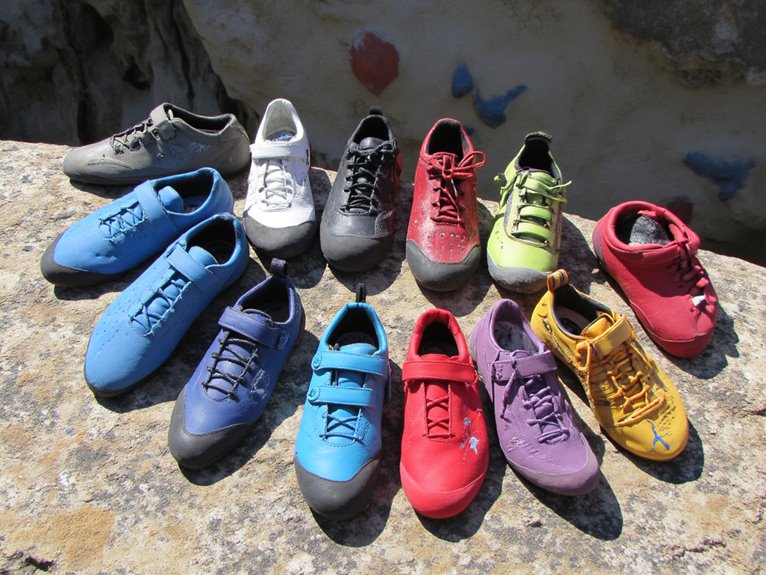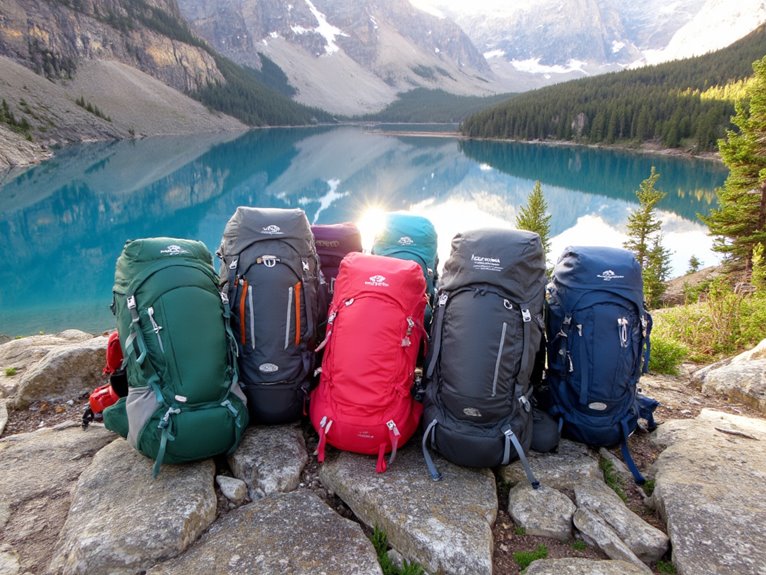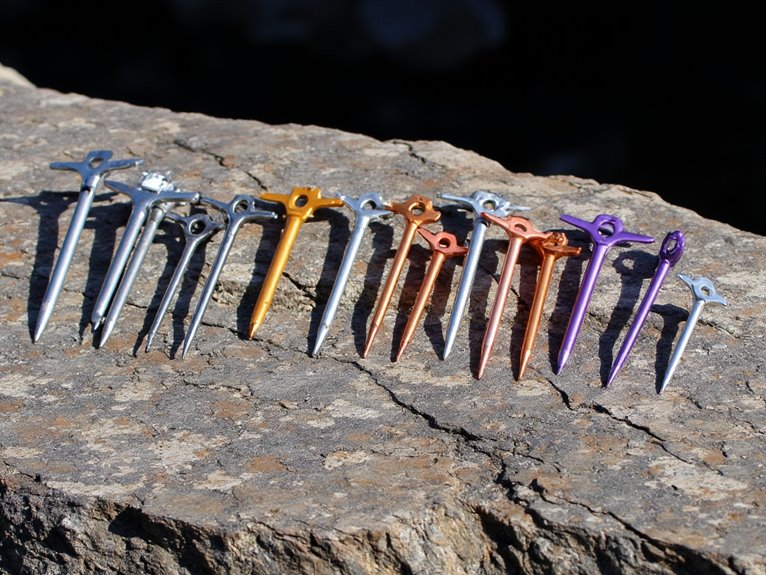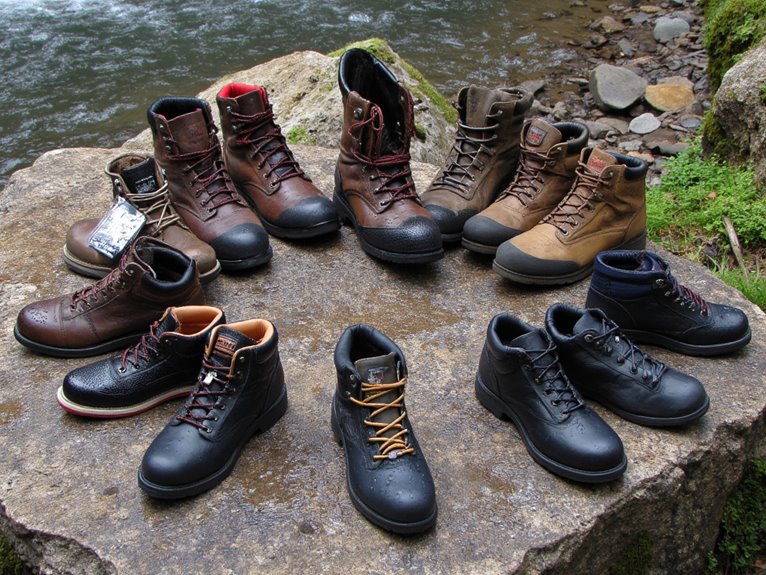10 Best Beginner Bouldering Shoes to Start Your Climbing Journey
I’ve researched the top beginner bouldering shoes based on comfort, sizing, and performance balance. The EVOLV Defy and Mad Rock Rover excel for newcomers with their forgiving fit and natural foot movement. CLIMBX Crush Lace offers excellent adjustability, while Ocun Striker QC prioritizes comfort over aggression. La Sportiva Solutions provide quality rubber compounds, though sizing runs small across most brands—expect 1-2 sizes smaller than street shoes. Budget $50-$150 for quality options that’ll support your progression without sacrificing essential comfort during extended climbing sessions.
We are supported by our audience. When you purchase through links on our site, we may earn an affiliate commission, at no extra cost for you. Learn more. Last update on 3rd December 2025 / Images from Amazon Product Advertising API.
Notable Insights
- Prioritize comfort over aggressive downturned designs as beginners need confidence-building shoes that allow natural foot movement during extended climbing sessions.
- Budget $50-$150 for quality beginner shoes, as investing in proper construction and materials prevents dissatisfaction and costly early replacements.
- Size up 1-2 sizes from street shoe size, with in-person fitting recommended due to inconsistent sizing across different brands.
- Choose lace closure systems for superior adjustability and precise fit, especially beneficial for varying foot shapes and wider feet.
- Look for quality rubber compounds and reinforced stitching in construction, as these features ensure better grip and durability during climbing.
Core Climbing Shoes – Lightweight Breathable Rock Shoes
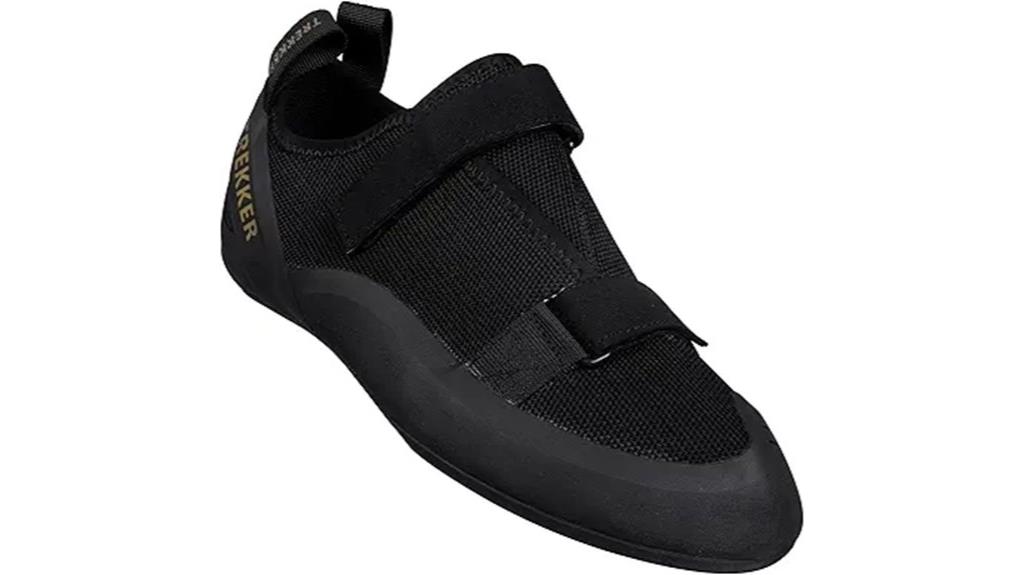
Core Climbing Shoes presents their Lightweight Breathable Rock Shoes as an entry-level option, though considerable design flaws make them problematic even for beginners who need forgiving, comfortable footwear.
You’ll encounter major sizing inconsistencies with these shoes. They run small, yet ordering your typical size down creates heel discomfort and ankle cutting. The dual Velcro closure system fails to provide adequate fit adjustment, with straps reportedly tearing after minimal use.
The shoe’s stiff construction and poor stitching quality compromise comfort during extended sessions. You’ll experience ankle digging from the rigid back panel, making these unsuitable for progression beyond basic indoor bouldering. The grip performance proves inadequate on challenging routes, limiting your climbing development potential considerably.
Best For: Complete beginners who need an extremely budget-friendly option for occasional indoor bouldering sessions and don’t mind significant comfort and performance limitations.
Pros:
- Lightweight design reduces foot fatigue during short climbing sessions
- Entry-level pricing makes them accessible for those testing interest in climbing
- Dual Velcro closure system allows for quick on/off between attempts
Cons:
- Major sizing inconsistencies with uncomfortable fit regardless of size chosen
- Poor grip performance limits progression beyond basic indoor routes
- Durability issues including strap failures and uncomfortable stiff construction that digs into ankles
CLIMBX Crush Lace NLV-Purple-Womens Rock Climbing/Bouldering Shoe
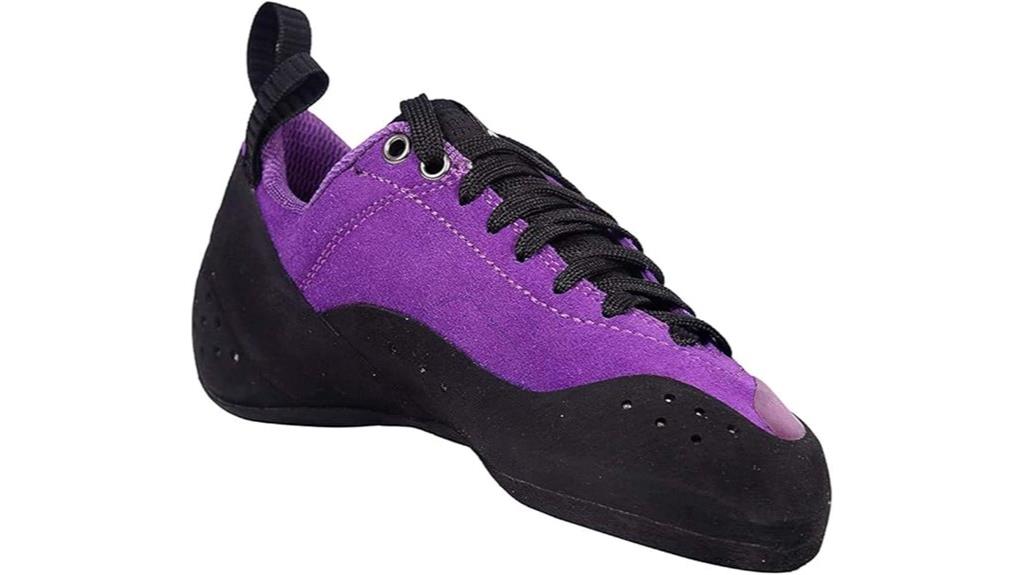
The CLIMBX Crush Lace NLV-Purple targets female climbers and male climbers with narrower feet through its specialized design that accommodates a higher instep, smaller overall dimensions, and reduced width compared to unisex models. Sizing inconsistencies affect ordering decisions. You’ll want your street size or half-size up rather than the traditional downsize. Some users report fit differences between left and right shoes.
You’ll find these shoes excel as affordable beginner options for indoor bouldering. The adjustable laces accommodate various foot widths effectively. Initial discomfort resolves during break-in periods. Quality matches the budget-friendly price point, though dye bleeding occurs but remains manageable. These shoes deliver reliable grip and performance for new climbers seeking cost-effective footwear.
Best For: Female climbers and males with narrower feet who are beginners seeking affordable, comfortable climbing shoes for indoor bouldering and gym use.
Pros:
- Designed specifically for female foot shape with higher instep and narrower width for better fit
- Excellent value for beginners with quality that matches the budget-friendly price point
- Adjustable laces accommodate various foot widths and provide customizable fit
Cons:
- Sizing inconsistencies require ordering street size or half-size up instead of traditional downsizing
- Some users experience fit differences between left and right shoes
- Dye bleeding occurs from the purple material, though it’s manageable
Ocun Jett Lu Bouldering Shoe | Rock Climbing Shoe
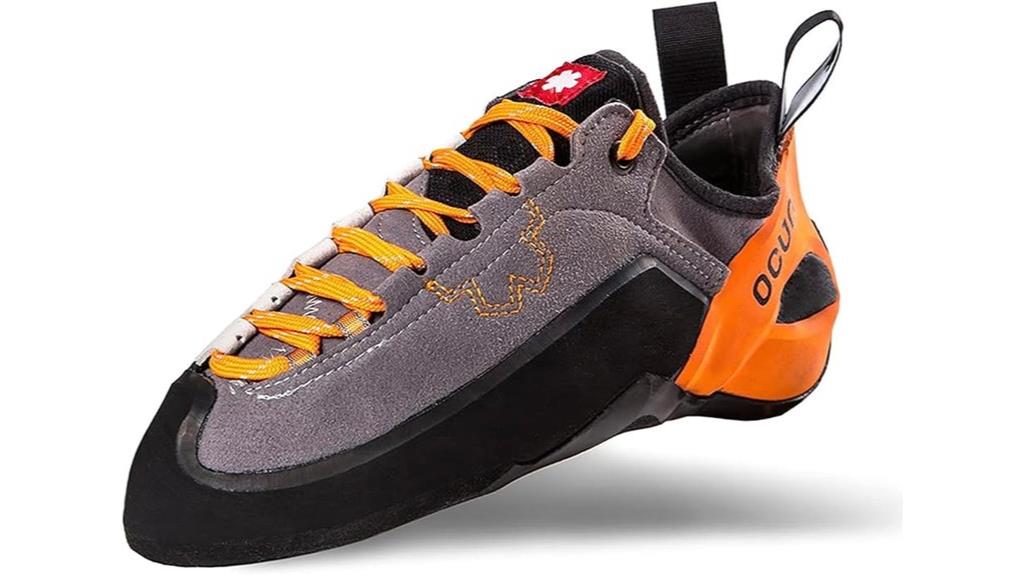
Ocun’s Jett Lu bouldering shoe strikes an ideal balance between precision and comfort that makes it perfect for climbers who prioritize extended gym sessions without sacrificing outdoor performance. You’ll experience immediate comfort on rock surfaces from day one. The shoe’s construction features quality materials that guarantee durability and justify its price point. You can expect excellent grip and stability through its specialized sole technology. While some discomfort may occur after 30 minutes of continuous use, your confidence in foot placement remains consistently high. The multicolored panels add visual appeal without compromising function. These shoes suit both beginners and experienced climbers, maintaining structural integrity during falls.
Best For: Climbers who want a versatile bouldering shoe that performs well in both gym sessions and outdoor climbing while providing a balance of precision and comfort.
Pros:
- Excellent grip and stability with specialized sole technology that enhances climbing performance
- Immediate comfort on rock surfaces with high-quality construction and durable materials
- Suitable for both beginners and experienced climbers with reliable structural integrity during falls
Cons:
- Some discomfort may occur after 30 minutes of continuous use
- Limited information about sizing guidance compared to other climbing shoe brands
- May require break-in period despite initial comfort for optimal long-term fit
Ocun Bullit Bouldering Shoe | Rock Climbing Shoe

Aggressive downsizing becomes less critical with the Ocun Bullit since these shoes run extremely small—often requiring climbers to size up 1.5 to 2 full sizes from their street shoe measurement. The toebox features a wider profile with gentle tapering, though fit varies greatly based on foot shape. Greek foot profiles typically achieve better accommodation than Egyptian profiles.
The Bullit delivers powerful toe performance with strategic flex placement and targeted stiffness zones. You’ll find adequate rubber thickness for edging despite some mid-foot softness. Construction quality remains solid with reliable grip characteristics for both bouldering and sport climbing applications.
Sizing accuracy determines satisfaction levels. Always reference seller measurements rather than standard sizing charts to avoid exchanges and potential discomfort during extended climbing sessions.
Best For: Climbers with Greek foot profiles who prioritize powerful toe performance and don’t mind sizing up significantly from their street shoe size for bouldering and sport climbing.
Pros:
- Powerful toe performance with strategic flex placement and targeted stiffness zones
- Solid construction quality with reliable grip for both bouldering and sport climbing
- Adequate rubber thickness for edging with wider toebox design
Cons:
- Runs extremely small, often requiring 1.5 to 2 full sizes up from street shoe size
- Poor fit for climbers with Egyptian foot profiles
- Mid-foot softness may compromise performance for some climbing styles
Ocun Striker QC Bouldering Shoe I Rock Climbing Shoe
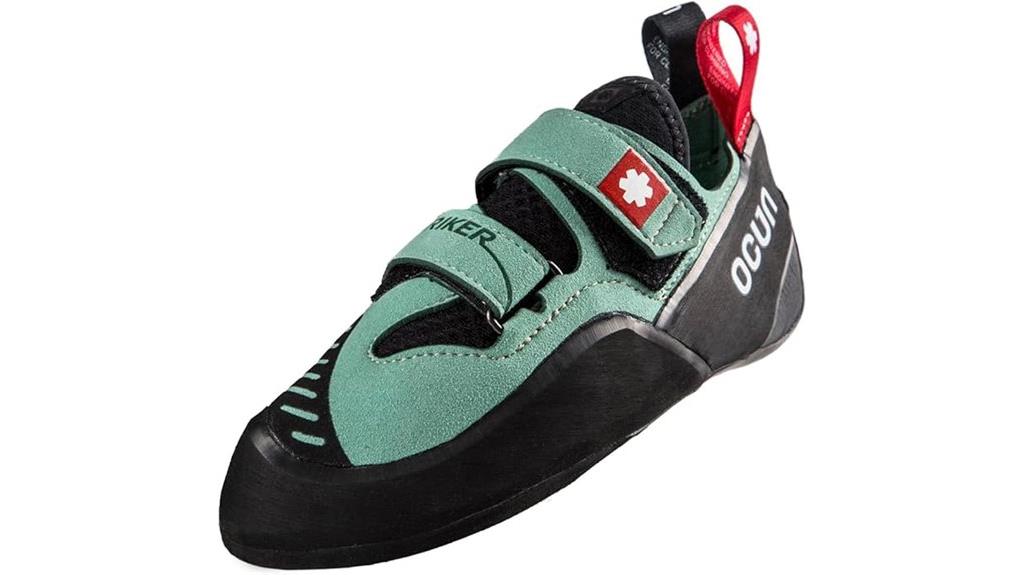
Comfort-focused climbers who prioritize extended sessions over aggressive performance will find their ideal match in the Ocun Striker QC. This non-aggressive shoe delivers exceptional comfort for long bouldering sessions without sacrificing essential grip performance.
Sizing runs accurate to slightly small. You’ll want to downsize 0.5 to 1 size from aggressive models. The flexible design accommodates natural foot movement while maintaining secure fit through adjustable straps.
The rubber compound provides reliable grip on both gym holds and outdoor rock. Multiple users report excellent durability after months of regular climbing. The shoe’s soft construction reduces hot spots and pressure points common in aggressive models.
You’re getting proven performance at an accessible price point, making this an excellent entry-level choice.
Best For: Comfort-focused climbers who prioritize extended bouldering sessions and beginners seeking a non-aggressive shoe with reliable grip performance at an accessible price point.
Pros:
- Exceptional comfort for long climbing sessions with soft, non-aggressive design that reduces hot spots and pressure points
- Reliable rubber compound provides excellent grip and durability on both gym holds and outdoor rock surfaces
- Accurate sizing with flexible construction that allows natural foot movement while maintaining secure fit through adjustable straps
Cons:
- Non-aggressive design may limit performance on steep overhangs and technical routes requiring precise edging
- Can feel loose if sized like other aggressive climbing shoes, requiring proper downsizing for optimal fit
- May not provide the sensitivity and precision needed for advanced climbing techniques compared to more aggressive models
Mad Rock Rover Climbing Shoe

Wide-footed climbers will find their perfect match in the Mad Rock Rover, a beginner-friendly shoe that prioritizes spacious toe boxes over aggressive downturns. The sticky rubber excels at heel hooks and toe smearing on indoor problems. You’ll appreciate the effective grip on small crimps, though toe sensitivity takes a backseat to durability.
Sizing runs inconsistent across the range. Order half to full size larger than your street shoe size. The asymmetrical shape works well for short boulder problems but may stress your feet during longer sessions.
Seam construction quality impresses most users, delivering solid value at this price point. The wide fit accommodates broader feet comfortably while maintaining adequate performance for gym climbing.
Best For: Wide-footed beginner climbers who prioritize comfort and spacious toe boxes for indoor bouldering and gym climbing sessions.
Pros:
- Sticky rubber provides excellent grip for heel hooks, toe smearing, and small crimps
- Wide fit with spacious toe box accommodates broader feet comfortably
- Solid seam construction quality delivers good value for the price point
Cons:
- Inconsistent sizing requires ordering half to full size larger than street shoe size
- Limited toe sensitivity due to prioritizing durability over precision feel
- Asymmetrical shape can stress feet during longer climbing sessions
La Sportiva Womens Tarantula Boulder All-Day Climbing Shoes

Female climbers seeking their first dedicated bouldering shoe will find the La Sportiva Women’s Tarantula delivers essential performance without overwhelming technical features. You’ll experience reliable grip on both gym holds and outdoor rock surfaces through the durable rubber sole construction. Order half a size larger than your street shoe size for ideal fit. The shoe’s snug profile provides necessary precision while maintaining all-day comfort during extended climbing sessions.
You may notice initial ankle pressure at the heel collar, though this typically diminishes during the break-in period. The adjustable strap system eliminates gaps and hotspots while maintaining consistent foot positioning. Beginners appreciate the shoe’s forgiving nature that doesn’t sacrifice climbing performance for comfort. Daily use won’t compromise durability, making these an excellent value proposition for new boulderers.
Best For: Beginner female climbers seeking their first dedicated bouldering shoe that offers reliable performance, all-day comfort, and excellent value for both gym and outdoor climbing.
Pros:
- Excellent grip and traction on both gym holds and outdoor rock surfaces with durable rubber sole construction
- Forgiving fit that maintains all-day comfort during extended climbing sessions without sacrificing performance
- Great value proposition with reliable durability for daily use and timely shipping from sellers
Cons:
- Initial ankle pressure and pinching at the heel collar that requires break-in time
- Some users experience rapid wear at the toe area depending on usage patterns
- Sizing can be tricky as half a size larger than street shoe size is recommended for proper fit
La Sportiva Womens Solution Rock Climbing Shoes
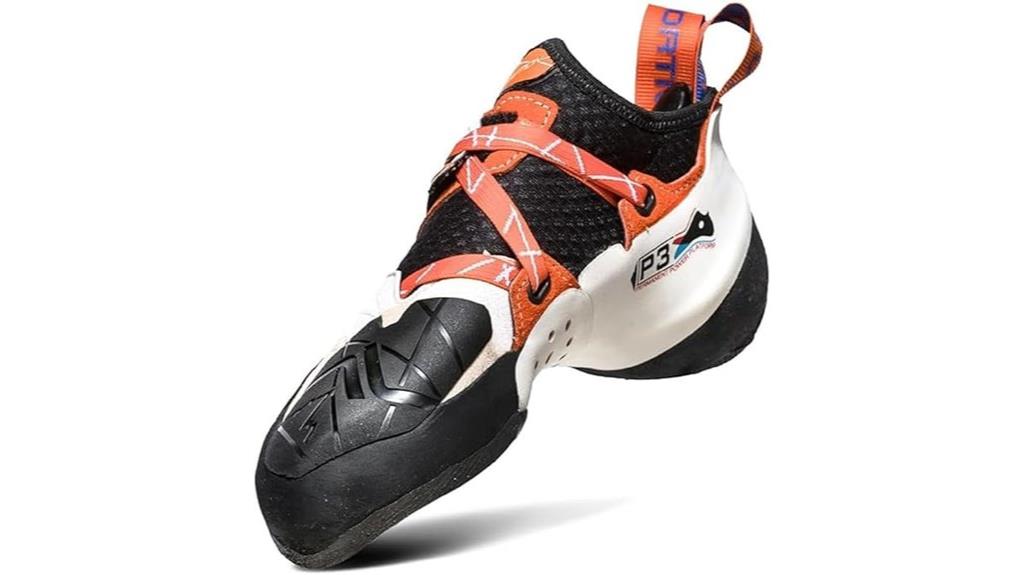
Although these shoes feature an aggressive downturned design that makes them unsuitable for true beginners, the La Sportiva Women’s Solution serves as an excellent choice for intermediate climbers ready to tackle more challenging boulder problems.
You’ll benefit from the Vibram XS Grip rubber and molded 3D heel cup for superior hooking performance. The patented P3 Power Platform maintains the shoe’s downturned shape permanently. This design excels at edging on small holds and toe hooking on overhangs.
The Lock Harness System provides secure heel retention during dynamic movements. You’ll find the Fast Lacing System allows quick adjustments between climbs. Sizing runs close to street shoe size, though some prefer half-size down.
Best For: Intermediate climbers with at least a year of experience who are ready to progress to aggressive climbing shoes for challenging boulder problems and technical routes requiring precise footwork.
Pros:
- Superior performance features including Vibram XS Grip rubber, molded 3D heel cup, and P3 Power Platform for excellent edging and heel hooking capabilities
- Accommodates longer toes and wider feet with a more forgiving fit compared to other aggressive climbing shoe brands
- Fast Lacing System and Lock Harness System provide quick adjustments and secure heel retention during dynamic movements
Cons:
- Aggressive downturned design makes them unsuitable for beginners and can cause discomfort during extended climbing sessions
- Higher price point raises concerns about long-term durability and value for the investment
- Heel cup and arch areas can cause significant discomfort, particularly during longer climbs or if foot placement isn’t optimal
EVOLV Defy Rock Climbing Shoe for Entry-Level Bouldering & Indoor Climbing
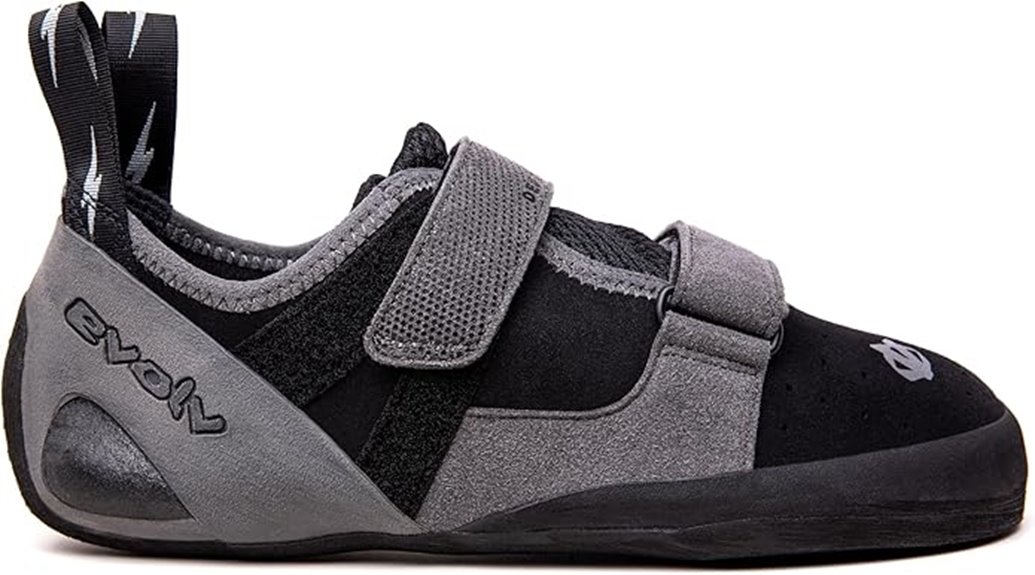
The EVOLV Defy Rock Climbing Shoe delivers exceptional value for climbers taking their first steps into bouldering and indoor climbing. These shoes feature single-layer vegan synthetic construction with strategic perforations that enhance breathability during extended sessions. The 1mm full-length midsole provides adequate support while maintaining sensitivity for foothold placement.
You’ll appreciate the slightly asymmetric toe profile that excels on vertical faces and moderate overhangs. The sizing runs true to standard climbing shoe measurements—order 8.5 when you typically wear 7.5-8 in street shoes. The soft sole construction prioritizes comfort over aggressive performance, making these ideal for all-day indoor training sessions. With regular 3-4 weekly usage, expect several months of reliable performance before requiring replacement.
Best For: Entry-level climbers and beginners who prioritize comfort and all-day wearability for indoor climbing and bouldering sessions.
Pros:
- Comfortable fit that’s true to size and suitable for extended climbing sessions
- Breathable vegan synthetic construction with perforations for temperature control
- Durable construction that lasts several months with regular 3-4 times weekly usage
Cons:
- Soft sole construction limits performance on aggressive climbing routes
- Single-layer design may lack the precision needed for advanced techniques
- Not optimized for outdoor climbing or technical edging on challenging terrain
La Sportiva Mens Solution Rock Climbing Shoe
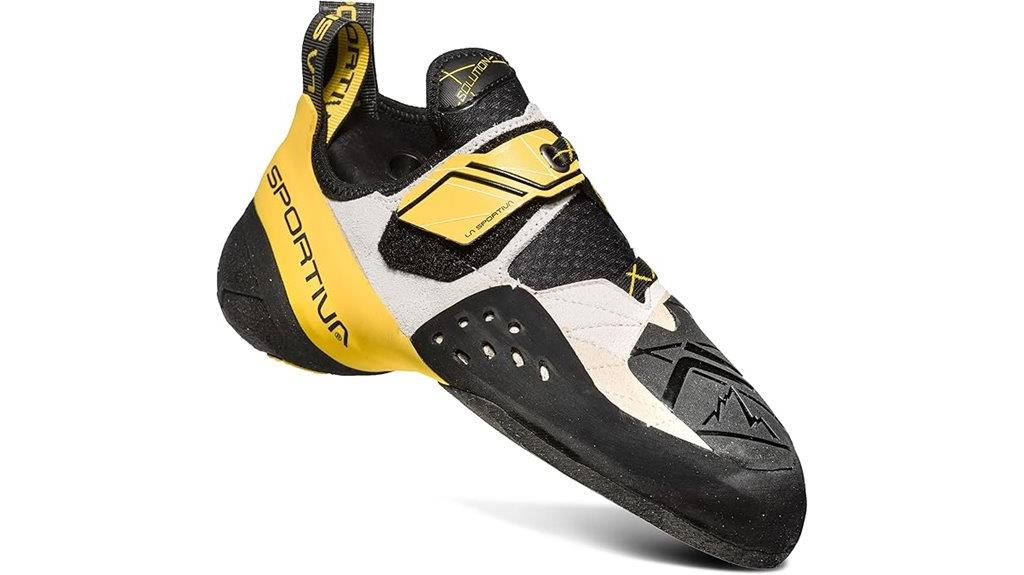
Advanced climbers seeking aggressive performance will find the La Sportiva Men’s Solution an exceptional choice, though beginners should approach with caution due to its highly technical design. These shoes run approximately four sizes smaller than standard footwear, requiring significant downsizing for proper fit. The aggressive profile delivers exceptional toe grip and precision on overhangs and technical routes.
You’ll notice immediate performance improvements in footwork precision and edging capability. The narrow last won’t accommodate wide feet comfortably. These shoes excel in bouldering and competition climbing where precise foot placement matters most.
La Sportiva’s construction quality guarantees durability under intensive use. However, the steep learning curve and aggressive fit make them unsuitable for newcomers to climbing. Consider these only after mastering fundamental techniques.
Best For: Advanced climbers who need aggressive, high-performance shoes for bouldering, competition climbing, and technical routes requiring precise footwork and exceptional toe grip.
Pros:
- Exceptional toe grip and precision on overhangs and technical routes with immediate performance improvements
- High-quality La Sportiva construction that guarantees durability under intensive climbing use
- Aggressive profile designed specifically for advanced techniques in bouldering and competition climbing
Cons:
- Runs approximately four sizes smaller than standard footwear, requiring significant downsizing
- Narrow last design won’t accommodate wide feet comfortably
- Steep learning curve and aggressive fit make them unsuitable for climbing beginners
Factors to Consider When Choosing Beginner Bouldering Shoes
I’ll guide you through five critical factors that determine whether your first bouldering shoes will help or hinder your climbing progress. Each factor directly impacts your performance on the wall and affects how quickly you’ll develop proper footwork techniques. Understanding these considerations before purchasing prevents costly mistakes and guarantees you select shoes that match your skill level and climbing goals.
Proper Sizing Guidelines
Getting bouldering shoes that fit properly becomes your first technical challenge as a beginner climber. Most bouldering shoes run 1-2 sizes smaller than your street shoe size. You’ll need to size up from your normal footwear to achieve comfort during extended climbing sessions.
Sizing down for performance is standard practice, but I recommend caution. Overly tight shoes cause pain and limit your session duration. Brand inconsistency creates additional complications. Each manufacturer uses different lasts and sizing standards, making in-person fitting essential.
Wide feet require special consideration. Look for adjustable lace systems or forgiving designs that accommodate broader foot shapes without performance compromise.
Test shoes carefully during initial trials. Proper fit means snug toe contact without excessive pressure, plus adequate support throughout your entire foot structure.
Comfort Vs Performance
While aggressive downturned shoes dominate professional climbing footage, comfort takes priority for beginners developing fundamental techniques. I recommend finding shoes that balance these competing demands rather than choosing extremes.
Comfortable shoes build confidence during extended sessions. Pain disrupts focus and limits training time. However, performance features like aggressive downturn and tight heel cups improve precision on technical holds. You’ll need both elements as you progress.
Look for moderately aggressive designs. These provide enhanced grip without excessive discomfort. The sweet spot offers snug fitting without cramping toes completely. Flexibility matters too—your foot needs movement range for various holds while maintaining stability.
Consider break-in periods carefully. Most climbing shoes start stiff but soften with use. This natural adaptation process improves comfort while preserving performance characteristics essential for skill development.
Budget Considerations
Budget constraints greatly impact your shoe selection, but smart spending delivers excellent value without breaking the bank. I recommend allocating $50-$150 for your first pair, with budget options providing solid quality-to-performance ratios for entry-level climbers. Investing in slightly pricier shoes yields better durability and comfort—crucial factors for frequent indoor sessions.
Consider the cost-to-benefit analysis carefully. Cheaper shoes often compromise grip and comfort, leading to dissatisfaction and premature replacements that increase long-term expenses. Monitor retailers for sales and discount codes to maximize purchasing power.
Understanding shoe lifecycle helps budget planning. Average usage expectancy spans several months with regular climbing. This timeframe allows you to evaluate both initial investment and future replacement costs, ensuring sustainable progression without overspending on your climbing journey.
Closure System Types
Your shoe’s closure system directly impacts performance, comfort, and convenience during bouldering sessions. Three primary systems dominate the market: Velcro straps, laces, and slip-on designs.
Velcro straps excel in quick removal between attempts. You’ll appreciate this feature during intensive bouldering sessions requiring frequent shoe breaks. However, they sacrifice precision fit compared to laced alternatives.
Laced systems provide superior adjustability across your entire foot. They accommodate varying foot shapes and allow micro-adjustments for peak performance. This versatility makes laces ideal if you experience sizing inconsistencies between brands.
Slip-on designs offer maximum convenience but compromise security and adjustability. They’re suitable for casual climbing but lack the precision required for challenging problems.
Consider your priorities: quick convenience favors Velcro, precise fit demands laces, and casual use accepts slip-on limitations.
Shoe Material Quality
Material quality determines your shoe’s lifespan, comfort, and climbing performance more than any other factor. I recommend focusing on three critical components when evaluating beginner shoes.
First, examine the upper construction. Vegan synthetic materials offer superior breathability and lighter weight compared to leather alternatives. These materials maintain their shape better during extended climbing sessions, preventing the uncomfortable stretching that plagues cheaper options.
Second, prioritize rubber compound quality. Sticky rubber formulations provide enhanced grip on holds and rock surfaces, allowing you to concentrate on technique development rather than compensating for poor traction.
Third, inspect stitching and construction methods. High-quality materials with reinforced stitching prevent premature wear and catastrophic failure during climbs. Poor construction leads to delamination, torn uppers, and sole separation—expensive problems that compromise safety and performance during your skill development phase.
Beginner-Friendly Features
Once you’ve identified shoes with quality materials, specific design features become vital for beginner success. I recommend prioritizing a slightly flexible construction over aggressive downturned models. This flexibility allows proper foot positioning while you’re developing fundamental techniques and building muscle memory.
Look for shoes with reliable closure systems. Velcro straps provide quick adjustments without complex lacing procedures. Quality rubber compounds deliver important grip on indoor climbing walls, preventing dangerous slips during your sessions.
Comfortable fit remains essential for extended training periods. Shoes shouldn’t cause immediate pain or restrict natural foot movement. Instead, they should feel snug without creating pressure points that discourage longer climbing sessions.
Consistent sizing helps guarantee proper fit. Always try shoes in person when possible, or follow manufacturer sizing charts carefully to achieve peak comfort and performance balance.
On a final note
I’ve presented the top-quality beginner bouldering shoes that’ll serve you well. Each shoe offers specific advantages: aggressive downturns for overhang problems, comfortable fits for extended sessions, or durable construction for outdoor use. Your climbing style and foot shape determine the best choice. Start with a moderately snug fit that’s comfortable for 30-minute sessions. You’ll shift to tighter, more aggressive shoes as your technique improves and pain tolerance increases.

